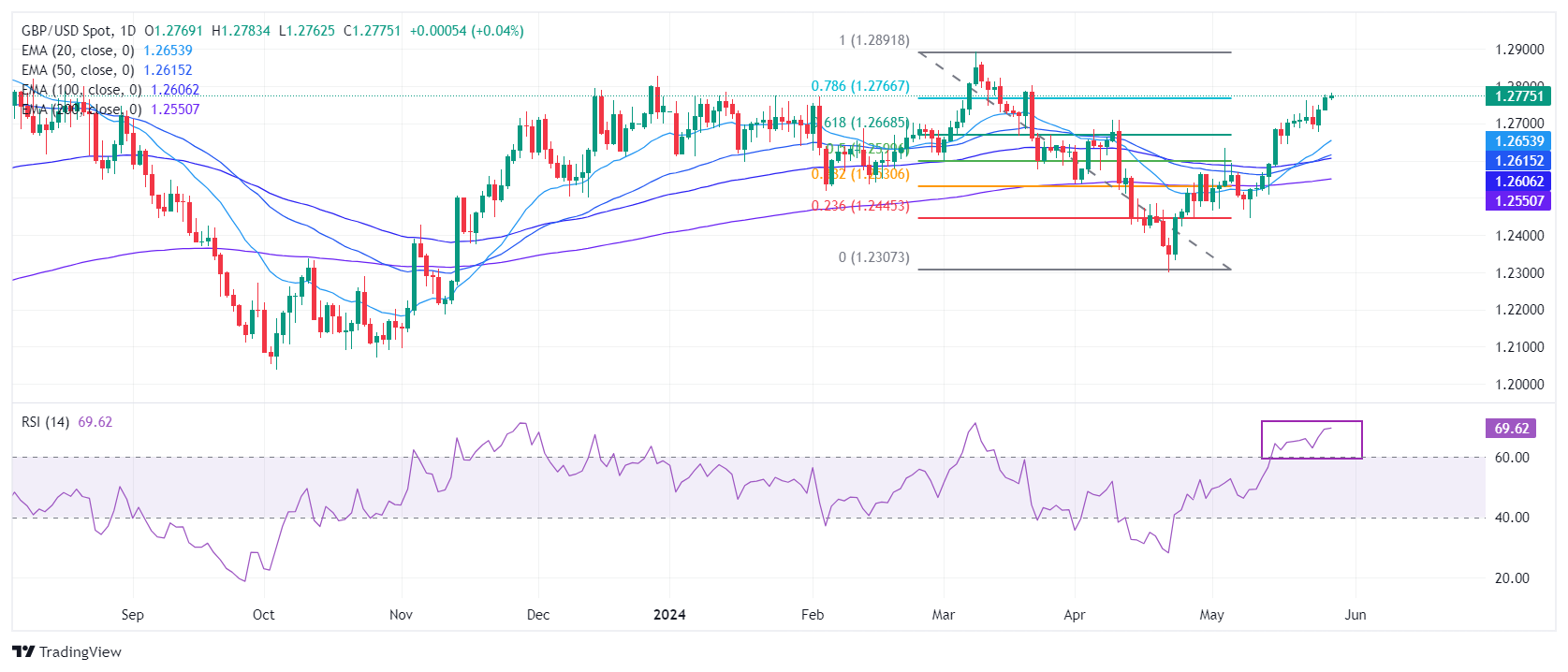- The Pound Sterling jumps to 1.2800 as the US Dollar declines with eyes on US core PCE inflation data.
- US core PCE inflation is forecasted to have grown at a steady pace on a monthly and an annual basis.
- A slower decline in the UK inflation in April diminished BoE rate-cut prospects.
The Pound Sterling (GBP) captures the round-level resistance of 1.2800 in Tuesday’s New York session. The strength in the GBP/USD pair is driven by the upbeat Pound Sterling, which capitalizes on risk-on sentiment and deepening uncertainty about when the Bank of England (BoE) will start reducing interest rates.
Earlier, investors expected the BoE to start reducing interest rates from the June meeting. Firm speculation for BoE rate cuts was built on expectations that the United Kingdom's annual headline inflation will return to the desired rate of 2% in April. BoE Governor Andrew Bailey said in an event organised by the International Monetary Fund (IMF) in Washington on April 16 that “inflation in the UK will fall near its 2% target next month” and “has declined roughly in step with the BoE’s forecast in February”, Bloomberg reported.
However, the pace at which the underlying inflation declined was insufficient to drag price pressures to the 2% target, and it softened to 2.3%. Apart from a slower decline in headline inflation, stubborn service inflation appears to be a major barrier that is making the last mile for price pressures towards the 2% target extremely stubborn.
Daily digest market movers: Pound Sterling jumps higher while US Dollar slumps
- The Pound Sterling advances to 1.2780 against the US Dollar as the latter is under pressure due to investors’ higher risk appetite. The appeal for risk-perceived assets has strengthened even though investors’ expectations for the Federal Reserve (Fed) reducing interest rates from the September meeting have diminished significantly.
- The CME FedWatch tool shows that traders see a roughly 50% chance of the Fed maintaining the current monetary policy framework in September. The odds of keeping rates unchanged have increased from 34% recorded a week ago. This could trigger a bullish reversal move in the US Dollar, which has been facing significant selling pressure since Friday. The US Dollar Index (DXY), which tracks the Greenback’s value against six major currencies, has posted a fresh weekly low near 104.40.
- Traders have pared Fed rate-cut bets as officials have reiterated that the current interest rate framework is sufficiently restrictive and needs to be held for a longer period until they are assured that inflation will sustainably return to the 2% target before considering rate cuts. Fed policymakers want to see price pressures declining for months to get that kind of confidence.
- Going forward, investors will focus on the United States (US) core Personal Consumption Expenditure Price Index (PCE) data for May, which will be published on Friday. The core PCE inflation data, which is the Fed’s preferred inflation measure, will provide fresh cues over the inflation outlook.
- Economists expect monthly and annual core PCE inflation to grow steadily by 0.3% and 2.8%, respectively. A hotter-than-expected inflation reading will be favorable for the US Dollar as it will force traders to pare dovish bets for September, while soft figures will do the opposite.
Technical Analysis: Pound Sterling rises to 1.2800
The Pound Sterling extends its upside to 1.2800 against the US Dollar. The appeal for the Cable strengthens as it reaches the 78.6% Fibonacci retracement (plotted from the March 8 high of 1.2900 to the April 22 low at 1.2300) at 1.2770.
The Cable is expected to remain bullish as all short-to-long-term Exponential Moving Averages (EMAs) are sloping higher, suggesting a strong uptrend.
The 14-period Relative Strength Index (RSI) has shifted into the bullish range of 60.00-80.00, suggesting that the momentum has leaned toward the upside.
US Dollar FAQs
The US Dollar (USD) is the official currency of the United States of America, and the ‘de facto’ currency of a significant number of other countries where it is found in circulation alongside local notes. It is the most heavily traded currency in the world, accounting for over 88% of all global foreign exchange turnover, or an average of $6.6 trillion in transactions per day, according to data from 2022. Following the second world war, the USD took over from the British Pound as the world’s reserve currency. For most of its history, the US Dollar was backed by Gold, until the Bretton Woods Agreement in 1971 when the Gold Standard went away.
The most important single factor impacting on the value of the US Dollar is monetary policy, which is shaped by the Federal Reserve (Fed). The Fed has two mandates: to achieve price stability (control inflation) and foster full employment. Its primary tool to achieve these two goals is by adjusting interest rates. When prices are rising too quickly and inflation is above the Fed’s 2% target, the Fed will raise rates, which helps the USD value. When inflation falls below 2% or the Unemployment Rate is too high, the Fed may lower interest rates, which weighs on the Greenback.
In extreme situations, the Federal Reserve can also print more Dollars and enact quantitative easing (QE). QE is the process by which the Fed substantially increases the flow of credit in a stuck financial system. It is a non-standard policy measure used when credit has dried up because banks will not lend to each other (out of the fear of counterparty default). It is a last resort when simply lowering interest rates is unlikely to achieve the necessary result. It was the Fed’s weapon of choice to combat the credit crunch that occurred during the Great Financial Crisis in 2008. It involves the Fed printing more Dollars and using them to buy US government bonds predominantly from financial institutions. QE usually leads to a weaker US Dollar.
Quantitative tightening (QT) is the reverse process whereby the Federal Reserve stops buying bonds from financial institutions and does not reinvest the principal from the bonds it holds maturing in new purchases. It is usually positive for the US Dollar.
Information on these pages contains forward-looking statements that involve risks and uncertainties. Markets and instruments profiled on this page are for informational purposes only and should not in any way come across as a recommendation to buy or sell in these assets. You should do your own thorough research before making any investment decisions. FXStreet does not in any way guarantee that this information is free from mistakes, errors, or material misstatements. It also does not guarantee that this information is of a timely nature. Investing in Open Markets involves a great deal of risk, including the loss of all or a portion of your investment, as well as emotional distress. All risks, losses and costs associated with investing, including total loss of principal, are your responsibility. The views and opinions expressed in this article are those of the authors and do not necessarily reflect the official policy or position of FXStreet nor its advertisers. The author will not be held responsible for information that is found at the end of links posted on this page.
If not otherwise explicitly mentioned in the body of the article, at the time of writing, the author has no position in any stock mentioned in this article and no business relationship with any company mentioned. The author has not received compensation for writing this article, other than from FXStreet.
FXStreet and the author do not provide personalized recommendations. The author makes no representations as to the accuracy, completeness, or suitability of this information. FXStreet and the author will not be liable for any errors, omissions or any losses, injuries or damages arising from this information and its display or use. Errors and omissions excepted.
The author and FXStreet are not registered investment advisors and nothing in this article is intended to be investment advice.
Recommended content
Editors’ Picks

EUR/USD bounces off lows, retests 1.1370
Following an early drop to the vicinity of 1.1310, EUR/USD now manages to regain pace and retargets the 1.1370-1.1380 band on the back of a tepid knee-jerk in the US Dollar, always amid growing optimism over a potential de-escalation in the US-China trade war.

GBP/USD trades slightly on the defensive in the low-1.3300s
GBP/USD remains under a mild selling pressure just above 1.3300 on Friday, despite firmer-than-expected UK Retail Sales. The pair is weighed down by a renewed buying interest in the Greenback, bolstered by fresh headlines suggesting a softening in the rhetoric surrounding the US-China trade conflict.

Gold remains offered below $3,300
Gold reversed Thursday’s rebound and slipped toward the $3,260 area per troy ounce at the end of the week in response to further improvement in the market sentiment, which was in turn underpinned by hopes of positive developments around the US-China trade crisis.

Ethereum: Accumulation addresses grab 1.11 million ETH as bullish momentum rises
Ethereum saw a 1% decline on Friday as sellers dominated exchange activity in the past 24 hours. Despite the recent selling, increased inflows into accumulation addresses and declining net taker volume show a gradual return of bullish momentum.

Week ahead: US GDP, inflation and jobs in focus amid tariff mess – BoJ meets
Barrage of US data to shed light on US economy as tariff war heats up. GDP, PCE inflation and nonfarm payrolls reports to headline the week. Bank of Japan to hold rates but may downgrade growth outlook. Eurozone and Australian CPI also on the agenda, Canadians go to the polls.

The Best brokers to trade EUR/USD
SPONSORED Discover the top brokers for trading EUR/USD in 2025. Our list features brokers with competitive spreads, fast execution, and powerful platforms. Whether you're a beginner or an expert, find the right partner to navigate the dynamic Forex market.




